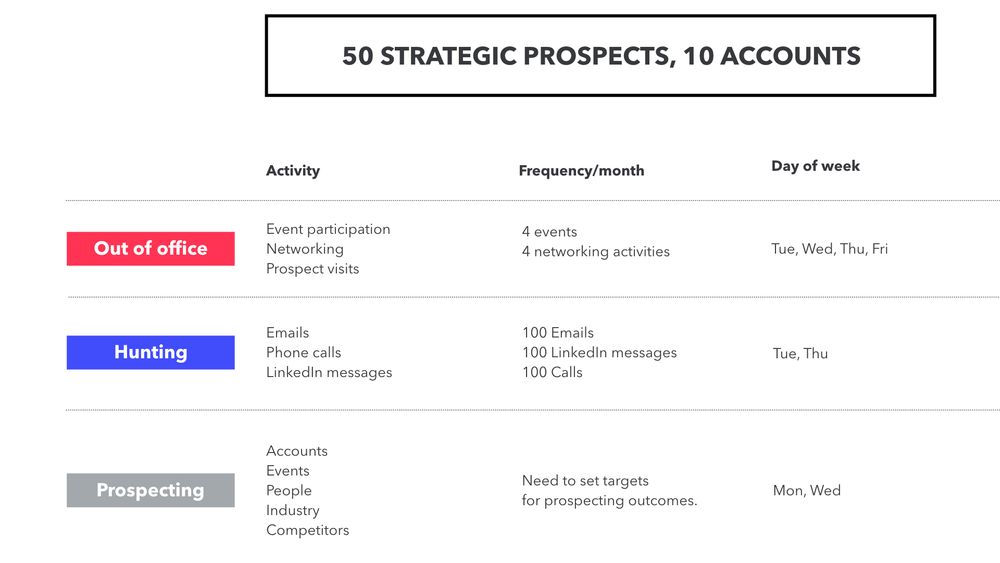Create value during sales process
Sales is often perceived as a wasteful, time-consuming process—more noise than signal. Maybe your prospect is too busy, annoyed because of previous negative software sales experiences, or simply unaware of the ROI a product can bring. Our job is to make them see the light.

I’ve found that creating value for future customers through each interaction completely dispels that stereotype. Because we’re not working together just yet, that value is information. Knowledge. My time investment toward making the prospect successful. Before I ask for a meeting—taking up precious time—I make sure I build up created value. Give and you shall receive. With each email, phone call, and LinkedIn message, I want to contribute and advance my customer’s success, instead of asking for favors. Before each interaction, ask yourself:
- Am I providing something valuable to my prospect?
- Is the information I am sharing timely?
- Is the information related to the industry and business?
- Is the information professionally written, well thought out, brief, and to the point?
As the process advances through emails, calls, and in-person capabilities meetings, always consider what else we could do that the prospect is not expecting. For example, before meeting with the CIO of a financial services group, work on a deck that evaluates the usability landscape of their current mobile applications or test several lending application processes and compare them for best practices, usability, and feature richness. Even if we repeat some things that they already know, it demonstrates our dedication, our understanding of their industry, and our willingness to go above and beyond.
Tracking activity levels

- Calls made (and comments/messages)
- Emails
- LinkedIn messages
- Campaigns mailed
- Capabilities sessions (remote and in person)
- Meetings (at events and focused)
- Workshops
- Proposals submitted
- “State of the union” meetings
The goal is to gather enough data over six to nine months to be able to correlate it to the outputs. Look for these things:
- The number of touchpoints it takes to get a capabilities session scheduled.
- The detailed breakdown of activities (how many calls, emails, messages, etc.) for prospects that convert into a capabilities session and ability to replicate the results.
- A pattern in timing for response rates.
- The overall volumes of various activities for a given week, and if that can be linked to specific output—say, you need a minimum of fifty calls a week to see the desired return.
Last, while all the above is important, the content and authenticity of your messaging trumps. Take the time to think through your messages, stay informed on the industry, and genuinely follow and pay attention to the developments of the accounts you are pursuing. You don’t need hundreds of accounts to progress, just a few. Promote focused, high-quality effort over sporadic, high-volume activity.
Develop multi-touchpoint scripts that are unique for your industry vertical and your buyer so that you don’t need to rewrite each message. Use your energy and creativity on making the messages tailored based on a recent news event or reference point.
Measuring engagement with tools
The better you can track your prospect’s engagement with your content, the timelier and more effective you can be with your follow-up. I use a combination of tools to gain this insight: LinkedIn, Pardot, Wistia statistics, and Bitly link encoding. This is my personal preference, so feel free to deviate from the norm. Here’s what my typical workflow looks like:
- Send an initial email from Pardot or LinkedIn; the email (or message) is tracked so I can tell if it has been opened and the links clicked. Pardot automatically sends notifications for these actions; you can further configure reporting to your needs.
- If triggered, I check LeadForensics and match the Pardot email engagement with a visit to our website from the target account. This doesn’t always work, but it does more often than not.
- If a video or a downloadable asset is involved, same as above.
- Once I have this intelligence, I do an immediate micro follow-up: “Hey, just noticed you read the article, here’s another crumb of valuable content that is related to the first.” I do this follow-up as close to the original interaction time as possible—sometimes within a matter of seconds.
- I use multiple channels to send these follow-ups—LinkedIn, email, personal phone. Don’t underestimate the value of persistence! Very few salespeople actually have the focus to pull this off, so the prospect will be surprised.
- While many other tools can be part of your process, immediate response and persistence sets you apart from the other hunters.
Build a habit of using the phone daily. It’s the last frontier of a live human connection in a modern outbound sales practice.